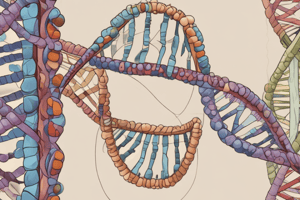Podcast
Questions and Answers
What is a phenotype?
What is a phenotype?
- The blueprint used by cells to make proteins
- Observable characteristics resulting from interactions between genes and environment (correct)
- A description of an organism's genetic material
- A molecule found inside living things
Which of the following is NOT one of the chemical building blocks of DNA?
Which of the following is NOT one of the chemical building blocks of DNA?
- Thymine
- Adenine
- Uracil (correct)
- Guanine
What is the role of DNA in cells?
What is the role of DNA in cells?
- To carry out cellular functions
- To produce observable characteristics in organisms
- To replicate itself during cell division
- To encode instructions for making proteins (correct)
Which biological molecules are responsible for the transmission of traits from parents to offspring?
Which biological molecules are responsible for the transmission of traits from parents to offspring?
In genetics, what term is used to describe traits that require both copies of a gene to be inherited for expression?
In genetics, what term is used to describe traits that require both copies of a gene to be inherited for expression?
What is the term for segments of DNA that code for specific proteins and determine physical traits?
What is the term for segments of DNA that code for specific proteins and determine physical traits?
When do dominant traits occur in offspring according to genetics?
When do dominant traits occur in offspring according to genetics?
Which type of inheritance deals specifically with genetic variations found on the sex chromosomes?
Which type of inheritance deals specifically with genetic variations found on the sex chromosomes?
What is a person's genotype?
What is a person's genotype?
Flashcards are hidden until you start studying
Study Notes
Heredity
Heredity refers to the transmission of traits from parents to their offspring through genes. It is a fundamental concept in biology that helps explain how organisms acquire characteristics through birth instead of being born with them. This process involves the transfer of information encoded within biological molecules such as deoxyribonucleic acid (DNA) from one generation to another.
Genetics
At its most basic level, heredity can be broken down into three main categories: dominant, recessive, and sex linked inheritance. Dominant traits occur when both copies of a gene are inherited from a parent; this means that even if only one copy has been received by the child, it will still express the trait. Recessive traits are those that do not manifest themselves unless two copies have been inherited by the individual. Sex-linked inheritance, also known as X-linked inheritance, deals specifically with genetic variations found on the sex chromosomes.
Genes themselves consist of segments of DNA called alleles which code for specific proteins. These proteins are responsible for determining the physical traits and behaviors of living creatures. For instance, hair color and eye shape are all determined by these protein structures coded for by our genes.
A person's genotype is the collection of genetic instructions they inherit from their parents. A phenotype, on the other hand, describes the observable characteristics resulting from interactions between an organism's genes and environment. Phenotypes may vary from person to person due to factors like diet, exercise habits, and lifestyle choices, although some phenotypical traits remain consistent across generations because they are determined primarily by genetic factors.
DNA
Deoxyribonucleic Acid (DNA), often referred to simply as 'genetic material', serves as the blueprint used by cells to make proteins, which carry out almost every cellular function. Each strand of DNA consists of four chemical building blocks—adenine (A), thymine (T), guanine (G), and cytosine (C). In nature, each base pairs up with another according to this rule: A always bonds with T while G pairs with C. By arranging these bases in different sequences, DNA encodes millions upon millions of unique instructions for making every type of molecule found inside living things.
The study of DNA led to the discovery of DNA replication, which is the process where a new DNA double helix is created from a pre-existing one during cell division. At its core, DNA replication ensures the accurate duplication of genetic material so that identical daughter cells receive identical sets of genetic instructions.
One important aspect of DNA is its ability to mutate over time – changes in its structure that can result from mistakes made during replication or exposure to various environmental agents. Some of these mutations can lead to disorders or diseases, but others play essential roles in evolution, shaping the diversity we observe among species today.
In conclusion, understanding heredity requires knowledge of key concepts including genetics, DNA structure, and the processes governing DNA replication and expression. This field encompasses various disciplines such as molecular biology, population genetics, and developmental biology, providing insights into life cycles, growth, disease, aging, and many more aspects of living systems.
Studying That Suits You
Use AI to generate personalized quizzes and flashcards to suit your learning preferences.




